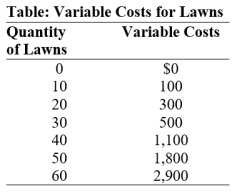Use the following to answer question: 
-(Table: Variable Costs for Lawns) Use Table: Variable Costs for Lawns.During the summer,Alex runs a lawn-mowing service,and lawn-mowing is a perfectly competitive industry.Assume that costs are constant in each interval;so,for example,the marginal cost of mowing each of the lawns from 1 through 10 is $10.Also assume that he can only mow the quantities of lawn given in the table (and not numbers in between) .His only fixed cost is $1,000 for the mower.His variable costs include fuel,his time,and mower parts.If the price for mowing a lawn is $60,how much is Alex's total revenue at the profit-maximizing output?
Definitions:
Rational Model
A decision-making approach based on logical and systematic analysis of information and alternatives to achieve the most reasonable outcome.
Optimize
The act of making something as effective, perfect, or useful as possible, often involving the allocation of resources in the most efficient way.
Satisfice
Satisfice is a decision-making strategy that involves choosing an option that meets the minimum requirements necessary for satisfaction, rather than optimizing for the best possible outcome.
Escalation of Commitment
A phenomenon where people increase their investment in a decision despite new evidence suggesting it may be wrong, often due to cognitive biases or emotional attachment.
Q11: Steven consumes staples and paper clips.He is
Q31: (Table: Variable Costs for Lawns)Use Table: Variable
Q51: (Table: Cost Data)Use Table: Cost Data.The average
Q80: (Figure: Cost Curves for Corn Producers)Use Figure:
Q82: The practice of charging different prices to
Q121: (Table: Cherry Farm)Use Table: Cherry Farm.If Hank
Q149: (Table: Cakes)Use Table: Cakes.Pat is opening a
Q278: The short-run industry supply curve:<br>A)shows the total
Q287: When a monopolist practices price discrimination,producer surplus
Q317: (Table: Cakes)Use Table: Cakes.Pat is opening a